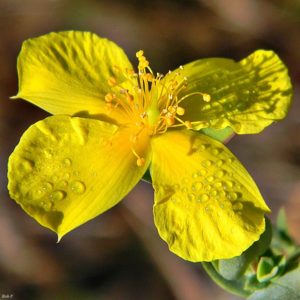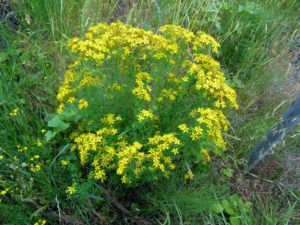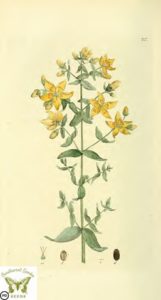April: Saint John’s Wort (Hypericum sp.)

“Springtime St. John’s Wort”, by bob_in_swamp, CC BY 2.0.
“St John’s wort doth charm all the witches away.
If gathered at midnight on the Saints holy day.
And devils and witches have no power to harm
Those that do gather the plant for a charm.
Rub the lintels and post with that red juicy flower
No thunder nor tempest will then have the power.
To hurt or to hinder your houses; and bind
Round your neck a charm of a similar kind.”
[From The Folklore of Staffordshire (1978) by J. Raven]
Take a stroll down your local pharmacy aisle, and you are likely to find the name “St. John’s Wort” among the shelves. The plant is known widely for its anti-depressant, healing, and protective qualities and has even been hung over doorways to ward off evil spirits. The herb is commonly gathered and dried for teas or made into a medicinal tincture or essential oil. St. John’s Wort typically blooms around June 24th, celebrated as Midsummer/St. John’s Day, which is where it derives its name. However, April is typically the month that its seed is sown, which is why it is our plant of the month!

“Common St. John’s Wort – Hypericum perfoliatum” [sic], by tlhowes2012, CC BY-NC-SA 2.0.
Saint John’s Wort belongs to the family Hypericaceae, commonly known as the “Saint John’s Wort Family”.
Various species of Saint John’s Wort include Saint Andrew’s Cross, Orangegrass, Saint Peter’s Wort, Piney Weed, and Common Saint John’s Wort, to name a few. This family’s major characteristics include clusters of small yellow flowers (sometimes tinged with orange or red) with 4 or 5 sepals and petals, and opposite stalkless leaves (attaching directly across from one another on the stem) that are pale green or yellow-green with clear dots. These dots are sacs of essential plant oils and are extracted by crushing. The nervine and sedative properties of the herb make it an attractive medicinal plant. The most significant risk of administering St. John’s Wort is the possible interaction with other drugs (so make sure to ask your doctor before self-medicating!). It is an erect, multi-stemmed, perennial forb (herbaceous flowering plant) that will typically grow to a height of 1 to 3 feet tall. The stems are reddish and woody at the base, leading to a tap root and vertical roots extending up to 5 feet below ground. St. John’s Wort produces a sticky seed pod containing small (about 1 mm long), dark, and round seeds that smell of turpentine.
Saint John’s Wort is commonly found in well-drained areas among grasslands, pastures, and even within forests in open areas. It is also likely to occur in areas disturbed by fire, road construction, and logging. St. Andrew’s Cross (Hypericum hypericoides) and Orangegrass (Hypericum gentianoides) are native to the eastern United States. However, Common Saint John’s Wort (Hypericum perforatum) is non-native, introduced from native origins such as Europe, North Africa, and western Asia.

“Hypericum perforatum. Svensk botanik [J.W. Palmstruch et al], vol.2 (1803)”, by Swallowtail Garden Seeds, CC PDM 1.0.
St. Andrew’s Cross (Hypericum hypericoides), Common Saint John’s Wort (Hypericum perforatum), and Orangegrass (Hypericum gentianoides) have all been used historically by the Cherokees and would have been common in a Three Sisters garden alongside corn, beans, and squash. Uses include application to snakebites by chewing the root, swallowing a portion and applying the rest; drinking teas for fever or bloody flux; bathing infants in a root tea for strength; sniffing the crushed plant to stop a nosebleed; rubbing the milky substance on sores; as well as drinking a mixed decoction of mad dog’s skullcap, hairy skullcap and squaw vine to promote menstruation. It was also used to treat venereal disease and bowel complaints.
In the first century, Greek physicians used the plant for wounds, as a diuretic, and for menstrual disorders. Other common uses have included anti-inflammatory, anti-bacterial, and disinfectant. St. John’s Wort has also been cited in folklore, such as in the folklore of the British Isles where superstitious Scots used the plant to ward off evil. The Midsummer Day is known to be a time where evil spirits are more present, and because St. John’s Wort blooms on or near this day, it has been seen as a light in the dark used for protection. St. John’s Wort tea has also been used as a folk remedy for bladder infections, dysentery, diarrhea, anxiety, depression, tuberculosis, stomach cancer, herpes, hemorrhoids, and as a sedative for disturbed sleep.
In addition to human uses of the plant, St. John’s Wort provides nectar to pollinators and is often used in pollinator restoration habitats!
For More Information:
Elpel, Thomas J. 1967. Botany in a Day: The Patterns Method of Plant Identification, An Herbal Field Guide to Plant Families of North America. HOPS Press. Pony, MT.
Moerman, Daniel E. 1998. Native American Ethnobotany. Timber Press, Portland, Oregon.
US Department of Agriculture, Natural Resources Conservation Service. 2021. PLANTS Database. Electronic document, https://plants.usda.gov/home.
Vickery, A.R. 1981. Traditional uses of folklore of Hypericum in the British Isles. Economic Botany, 35(3), 289–295.
